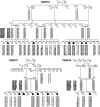Mutations of MYO6 are associated with recessive deafness, DFNB37
- PMID: 12687499
- PMCID: PMC1180285
- DOI: 10.1086/375122
Mutations of MYO6 are associated with recessive deafness, DFNB37
Abstract
Cosegregation of profound, congenital deafness with markers on chromosome 6q13 in three Pakistani families defines a new recessive deafness locus, DFNB37. Haplotype analyses reveal a 6-cM linkage region, flanked by markers D6S1282 and D6S1031, that includes the gene encoding unconventional myosin VI. In families with recessively inherited deafness, DFNB37, our sequence analyses of MYO6 reveal a frameshift mutation (36-37insT), a nonsense mutation (R1166X), and a missense mutation (E216V). These mutations, along with a previously published missense allele linked to autosomal dominant progressive hearing loss (DFNA22), provide an allelic spectrum that probes the relationship between myosin VI dysfunction and the resulting phenotype.
Figures




Similar articles
-
A novel nonsense mutation in MYO6 is associated with progressive nonsyndromic hearing loss in a Danish DFNA22 family.Am J Med Genet A. 2008 Apr 15;146A(8):1017-25. doi: 10.1002/ajmg.a.32174. Am J Med Genet A. 2008. PMID: 18348273
-
MYO6, the human homologue of the gene responsible for deafness in Snell's waltzer mice, is mutated in autosomal dominant nonsyndromic hearing loss.Am J Hum Genet. 2001 Sep;69(3):635-40. doi: 10.1086/323156. Epub 2001 Jul 20. Am J Hum Genet. 2001. PMID: 11468689 Free PMC article.
-
Characterization of unconventional MYO6, the human homologue of the gene responsible for deafness in Snell's waltzer mice.Hum Mol Genet. 1997 Aug;6(8):1225-31. doi: 10.1093/hmg/6.8.1225. Hum Mol Genet. 1997. PMID: 9259267
-
Clinical Characteristics and In Vitro Analysis of MYO6 Variants Causing Late-Onset Progressive Hearing Loss.Genes (Basel). 2020 Mar 4;11(3):273. doi: 10.3390/genes11030273. Genes (Basel). 2020. PMID: 32143290 Free PMC article.
-
Unconventional myosins and the genetics of hearing loss.Am J Med Genet. 1999 Sep 24;89(3):147-57. doi: 10.1002/(sici)1096-8628(19990924)89:3<147::aid-ajmg5>3.0.co;2-6. Am J Med Genet. 1999. PMID: 10704189 Review.
Cited by
-
Molecular genetics of non-syndromic deafness.Braz J Otorhinolaryngol. 2005 Mar-Apr;71(2):216-23. doi: 10.1016/s1808-8694(15)31313-6. Epub 2005 Aug 2. Braz J Otorhinolaryngol. 2005. PMID: 16446920 Free PMC article. Review.
-
Myosin VI and VIIa distribution among inner ear epithelia in diverse fishes.Hear Res. 2007 Feb;224(1-2):15-26. doi: 10.1016/j.heares.2006.11.004. Epub 2007 Jan 3. Hear Res. 2007. PMID: 17204383 Free PMC article.
-
Pathophysiology of human hearing loss associated with variants in myosins.Front Physiol. 2024 Mar 18;15:1374901. doi: 10.3389/fphys.2024.1374901. eCollection 2024. Front Physiol. 2024. PMID: 38562617 Free PMC article. Review.
-
Critical role of TPRN rings in the stereocilia for hearing.Mol Ther. 2024 Jan 3;32(1):204-217. doi: 10.1016/j.ymthe.2023.11.011. Epub 2023 Nov 11. Mol Ther. 2024. PMID: 37952086 Free PMC article.
-
Myosin VI and cardiomyopathy: Left ventricular hypertrophy, fibrosis, and both cardiac and pulmonary vascular endothelial cell defects in the Snell's waltzer mouse.Cytoskeleton (Hoboken). 2015 Aug;72(8):373-87. doi: 10.1002/cm.21236. Cytoskeleton (Hoboken). 2015. PMID: 26265212 Free PMC article.
References
Electronic-Database Information
-
- Center for Medical Genetics, Marshfield Medical Research Foundation, http://research.marshfieldclinic.org/genetics/
-
- Hereditary Hearing Loss Homepage, http://www.uia.ac.be/dnalab/hhh/
-
- GenBank, http://www.ncbi.nlm.nih.gov/Genbank/ (for MYO6 [accession number AB002387])
-
- Online Mendelian Inheritance in Man (OMIM), http://www.ncbi.nlm.nih.gov/Omim/ (for DFNA22) - PubMed
-
- Primer3 Web-Based Server, http://www.genome.wi.mit.edu/cgi-bin/primer/primer3_www.cgi
References
-
- Ahituv N, Sobe T, Robertson NG, Morton CC, Taggart RT, Avraham KB (2000) Genomic structure of the human unconventional myosin VI gene. Gene 261:269–275 - PubMed
-
- Avraham KB, Hasson T, Sobe T, Balsara B, Testa JR, Skvorak AB, Morton CC, Copeland NG, Jenkins NA (1997) Characterization of unconventional MYO6, the human homologue of the gene responsible for deafness in Snell’s waltzer mice. Hum Mol Genet 6:1225–1231 - PubMed
-
- Avraham KB, Hasson T, Steel KP, Kingsley DM, Russell LB, Mooseker MS, Copeland NG, Jenkins NA (1995) The mouse Snell’s waltzer deafness gene encodes an unconventional myosin required for structural integrity of inner ear hair cells. Nat Genet 11:369–375 - PubMed
Publication types
MeSH terms
Substances
Associated data
- Actions
Grants and funding
LinkOut - more resources
Full Text Sources
Medical
Molecular Biology Databases

